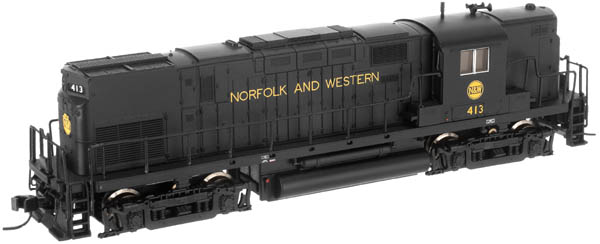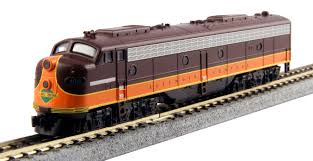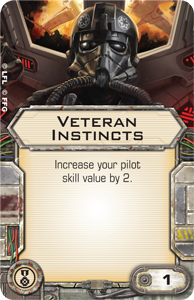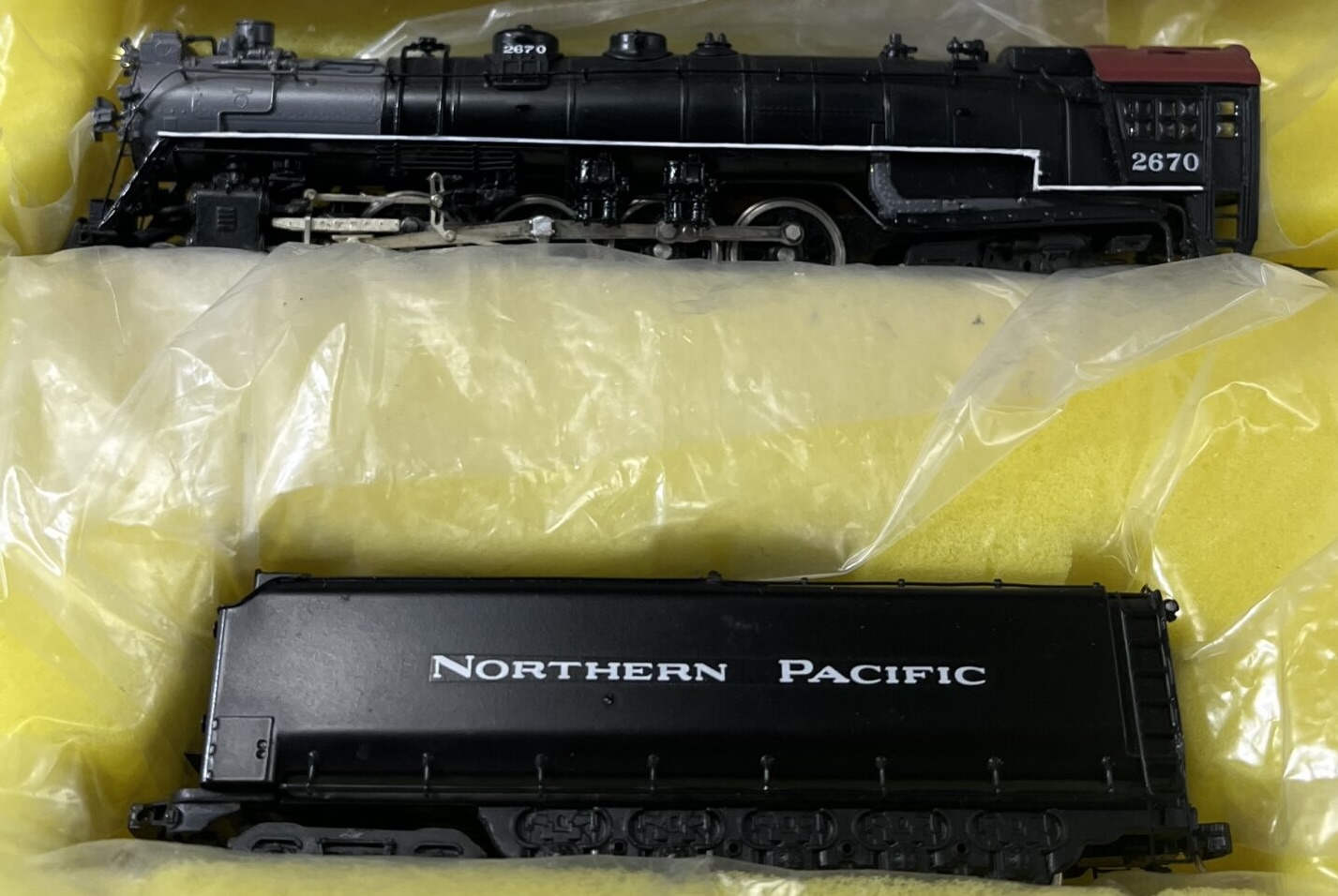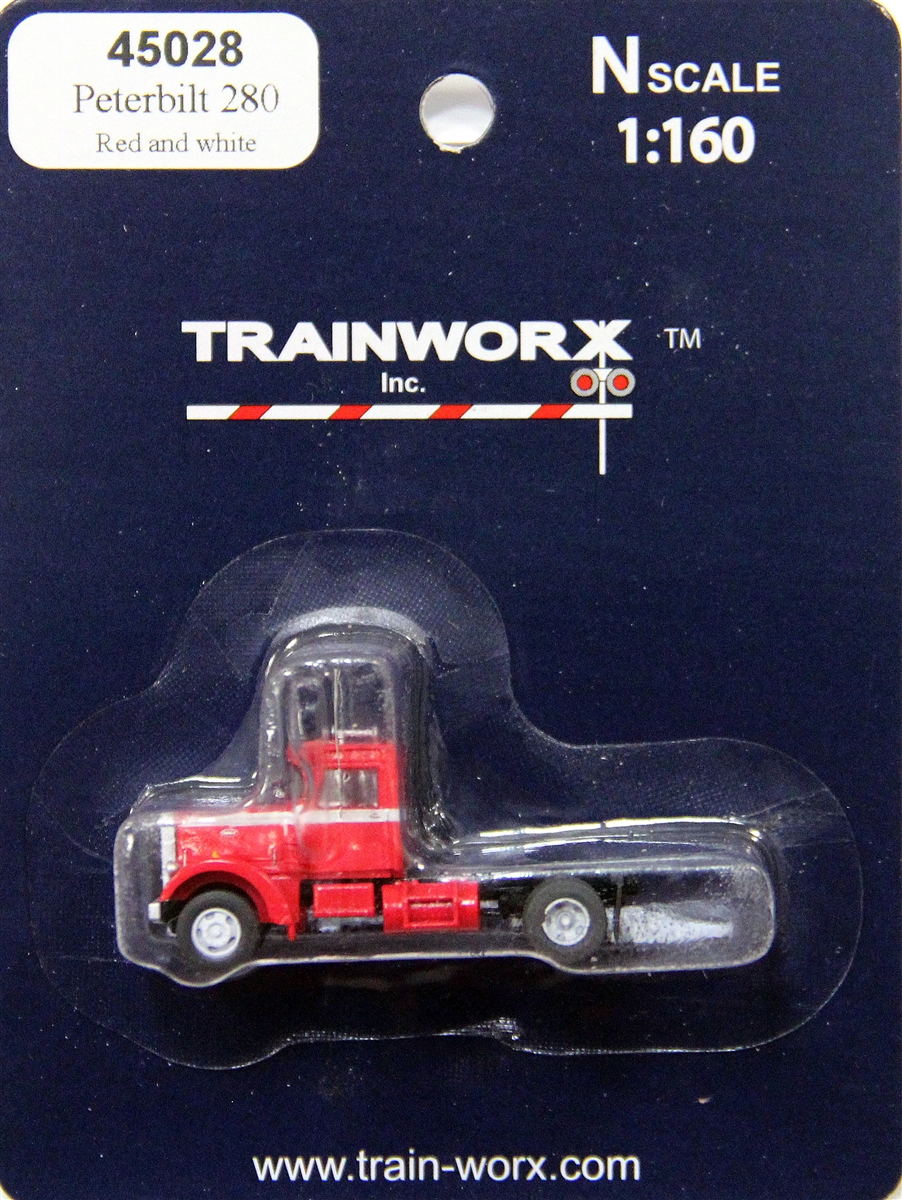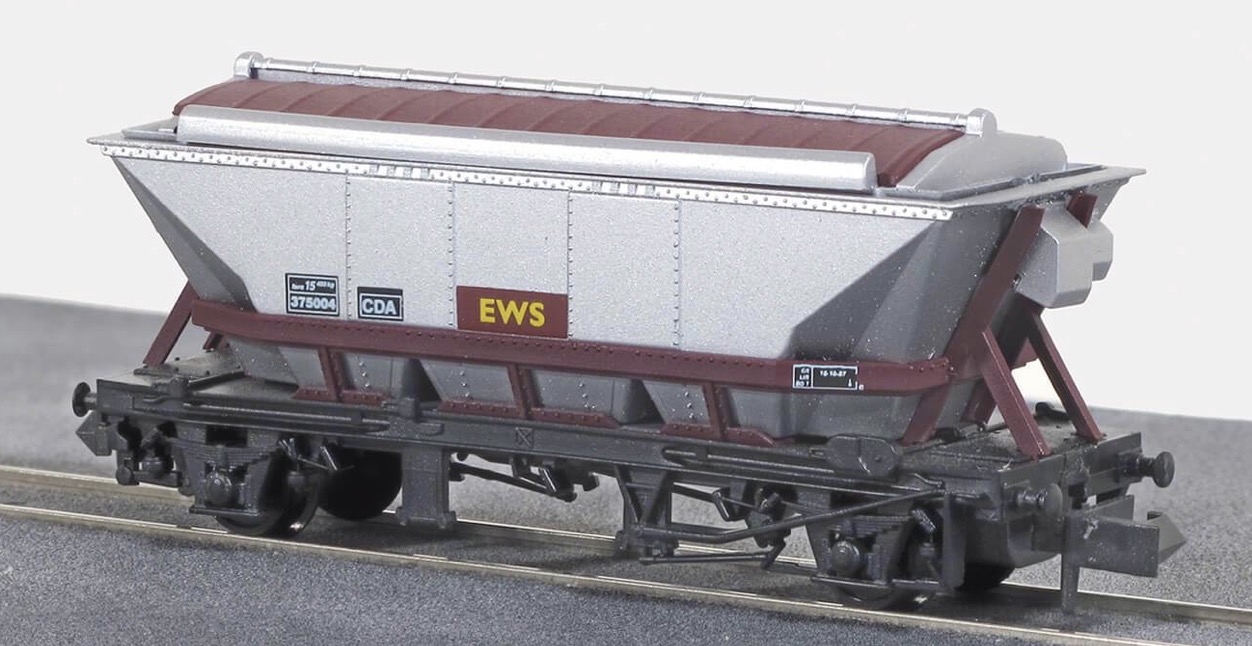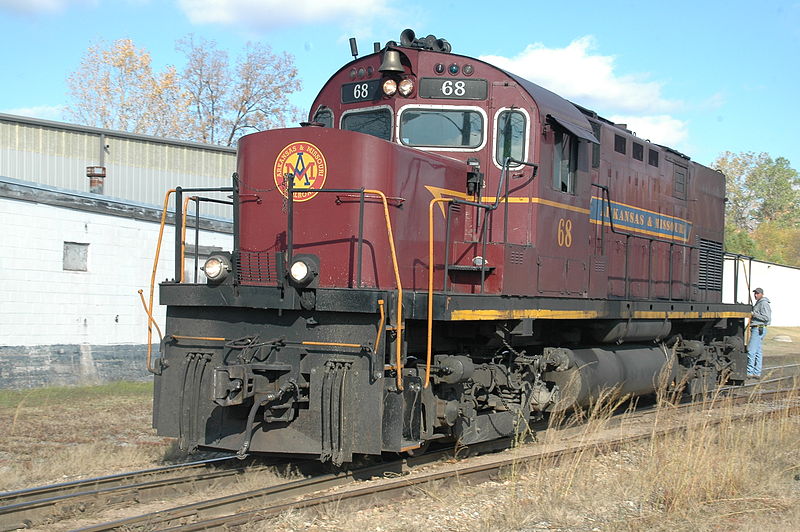Model Information: Atlas first released this model of the Century 420 (C420) in 2007. The first release of the C420 was a low-nose “phase 1” model. The combination of stanchions mounted into the top of the walkway deck and a high-mounted engine air intake (located ahead of the radiator area) identifies this C420 variant. Phase 1 models were produced between June 1963 and October 1964 and this first production run covers all original owners of the low nose version.
Atlas’ 2008 second release of the C420 is a low-nose “phase 2” model. All Phase 2 versions feature the low/vertical mounted engine air intake located ahead of the radiator area on the long hood. Early phase 2 locomotives feature phase 1-style walkways/sills with stanchions mounted into the top walkway deck (referred to as “Phase 2a” models). Later phase 2 locomotives feature a revised configuration where the stanchions are mounted to the sides of the sill (referred to as “Phase 2b” models). Phase 2a production ran from December 1964 through September 1965. Phase 2b units were produced from December 1965 through the end of C420 locomotive production in August 1968.
The C-420 has the standard attributes of modern Atlas models. The chassis is fully DCC-Ready (and, in fact, available with factory-installed decoder). These models perform excellently; they are quiet, responsive and powerful.
Standard Features: Flat or "step" pilots used where appropriate; Long hood with or without dynamic brake detail used where appropriate; 3,100 gallon fuel tank; Separately-applied coupler cut levers; Painted safety rails; Dual flywheels; Directional lighting and a Scale Speed motor.
Atlas’ 2008 second release of the C420 is a low-nose “phase 2” model. All Phase 2 versions feature the low/vertical mounted engine air intake located ahead of the radiator area on the long hood. Early phase 2 locomotives feature phase 1-style walkways/sills with stanchions mounted into the top walkway deck (referred to as “Phase 2a” models). Later phase 2 locomotives feature a revised configuration where the stanchions are mounted to the sides of the sill (referred to as “Phase 2b” models). Phase 2a production ran from December 1964 through September 1965. Phase 2b units were produced from December 1965 through the end of C420 locomotive production in August 1968.
The C-420 has the standard attributes of modern Atlas models. The chassis is fully DCC-Ready (and, in fact, available with factory-installed decoder). These models perform excellently; they are quiet, responsive and powerful.
Standard Features: Flat or "step" pilots used where appropriate; Long hood with or without dynamic brake detail used where appropriate; 3,100 gallon fuel tank; Separately-applied coupler cut levers; Painted safety rails; Dual flywheels; Directional lighting and a Scale Speed motor.
Prototype History: ALCo built a total of 131 Century 420 locomotives between 1963 and 1969, when the builder ceased all new locomotive production. Powered by a 12-cylinder, turbocharged, 2,000-hp 251-series prime mover, the C420’s direct competitor in 1963 was the EMD GP18. In fact, EMD did not offer a 12-cylinder, 2,000-hp prime mover until the GP39 model was produced in 1969. The shorter 12-cylinder engine block allowed the C420 to have its distinctive set-back cab and extended short hood.
The first road to purchase the C420 was the Lehigh & Hudson River, with its first two units built in 1963. The largest fleet was purchased by the Long Island Railroad, with 30 units built between 1963 and 1968. All were equipped with a high short hood which housed a steam generator for passenger service. Over time, the largest fleet of C420s was amassed by the Louisville & Nashville. While only 26 units were purchased new, their total fleet grew to well over 60 units through mergers and acquisitions. The C420 can still be found in daily service today in the US. Currently the largest fleet of C420s is operated by the Arkansas & Missouri Railroad.
The first road to purchase the C420 was the Lehigh & Hudson River, with its first two units built in 1963. The largest fleet was purchased by the Long Island Railroad, with 30 units built between 1963 and 1968. All were equipped with a high short hood which housed a steam generator for passenger service. Over time, the largest fleet of C420s was amassed by the Louisville & Nashville. While only 26 units were purchased new, their total fleet grew to well over 60 units through mergers and acquisitions. The C420 can still be found in daily service today in the US. Currently the largest fleet of C420s is operated by the Arkansas & Missouri Railroad.
Road Name History: The Norfolk and Western Railway (reporting mark NW), was a US class I railroad, formed by more than 200 railroad mergers between 1838 and 1982. It was headquartered in Roanoke, Virginia, for most of its 150-year existence. Its motto was "Precision Transportation"; it had a variety of nicknames, including "King Coal" and "British Railway of America" even though the N&W had mostly articulated steam on its roster. During the Civil War, the N&W was the biggest railroad in the south and moved most of the products with their steam locomotives to help the South the best way they could.
NW was famous for manufacturing its own steam locomotives, which were produced at the Roanoke Shops, as well as its own hopper cars. Around 1960, NW became the last major American railroad to convert from steam locomotives to diesel motive power but didn't retire its last remaining Y class locomotives until 1964 and 1965. By 1965, steam on class I railroads was gone but steam wasn't gone on class II railroads until 1974 and class III and mining railroads retired their steam locomotives from their active roster until 1983. By 1983, steam in America on class I, II, III, and mining railroads had finally closed the chapter on America's 150 years of steam from 1830 - 1983.
In December 1959, NW merged with the Virginian Railway (reporting mark VGN), a longtime rival in the Pocahontas coal region. By 1970, other mergers with the Nickel Plate Road and Wabash formed a system that operated 7,595 miles (12,223 km) of road on 14,881 miles (23,949 km) of track from North Carolina to New York and from Virginia to Iowa.
In 1980, NW teamed up with the Southern Railway, another profitable carrier and created the Norfolk Southern Corporation holding company by merging its business operations with the business operations of the Southern Railway. The NW and the Southern Railway continued as separate railroads now under one holding company.
On December 31, 1990, the Southern Railway was renamed "Norfolk Southern Railway" to reflect the Norfolk Southern Corporation and on the same day, the renamed Norfolk Southern Railway gained full control of the Norfolk and Western Railway with the Norfolk and Western being transferred from the holding company to the renamed Norfolk Southern Railway, this began the final years of Norfolk and Western which was absorbed into the renamed Norfolk Southern Railway seven years later in 1997 (1990 to 1997 the Norfolk and Western continued operating by using paper operations).
In 1997 during the Conrail battle with CSX, Norfolk Southern Corporation's principal railroad, the renamed Norfolk Southern Railway, absorbed the Norfolk and Western Railway into their rail system, ending the existence of the Norfolk and Western Railway and having the renamed Norfolk Southern Railway becoming the only railroad in the entire Norfolk Southern system after that.
NW was famous for manufacturing its own steam locomotives, which were produced at the Roanoke Shops, as well as its own hopper cars. Around 1960, NW became the last major American railroad to convert from steam locomotives to diesel motive power but didn't retire its last remaining Y class locomotives until 1964 and 1965. By 1965, steam on class I railroads was gone but steam wasn't gone on class II railroads until 1974 and class III and mining railroads retired their steam locomotives from their active roster until 1983. By 1983, steam in America on class I, II, III, and mining railroads had finally closed the chapter on America's 150 years of steam from 1830 - 1983.
In December 1959, NW merged with the Virginian Railway (reporting mark VGN), a longtime rival in the Pocahontas coal region. By 1970, other mergers with the Nickel Plate Road and Wabash formed a system that operated 7,595 miles (12,223 km) of road on 14,881 miles (23,949 km) of track from North Carolina to New York and from Virginia to Iowa.
In 1980, NW teamed up with the Southern Railway, another profitable carrier and created the Norfolk Southern Corporation holding company by merging its business operations with the business operations of the Southern Railway. The NW and the Southern Railway continued as separate railroads now under one holding company.
On December 31, 1990, the Southern Railway was renamed "Norfolk Southern Railway" to reflect the Norfolk Southern Corporation and on the same day, the renamed Norfolk Southern Railway gained full control of the Norfolk and Western Railway with the Norfolk and Western being transferred from the holding company to the renamed Norfolk Southern Railway, this began the final years of Norfolk and Western which was absorbed into the renamed Norfolk Southern Railway seven years later in 1997 (1990 to 1997 the Norfolk and Western continued operating by using paper operations).
In 1997 during the Conrail battle with CSX, Norfolk Southern Corporation's principal railroad, the renamed Norfolk Southern Railway, absorbed the Norfolk and Western Railway into their rail system, ending the existence of the Norfolk and Western Railway and having the renamed Norfolk Southern Railway becoming the only railroad in the entire Norfolk Southern system after that.
Brand/Importer Information: In 1924 Stephan Schaffan, Sr. founded the Atlas Tool Company in Newark, New Jersey. In 1933 his son, Stephan Schaffan, Jr., came to work for his father at the age of sixteen. Steve Jr. built model airplanes as a hobby and frequented a local hobby shop. Being an enterprising young man, he would often ask the owner if there was anything he could do to earn some extra spending money. Tired of listening to his requests, the hobby-store owner threw some model railroad track parts his way and said, "Here, see if you can improve on this".
In those days, railroad modelers had to assemble and build everything from scratch. Steve Jr. created a "switch kit" which sold so well, that the entire family worked on them in the basement at night, while doing business as usual in the machine shop during the day.
Subsequently, Steve Jr. engineered the stapling of rail to fiber track, along with inventing the first practical rail joiner and pre-assembled turnouts and flexible track. All of these products, and more, helped to popularize model railroading and assisted in the creation of a mass-market hobby. The budding entrepreneur quickly outgrew the limitations of a basement and small garage operation. Realizing they could actually make a living selling track and related products, Steve and his father had the first factory built in Hillside, New Jersey at 413 Florence Avenue in 1947. On September 30, 1949, the Atlas Tool Company was officially incorporated as a New Jersey company.
In 1985, Steve was honored posthumously for his inventions by the Model Railroad Industry Association and was inducted into the Model Railroad Industry Hall of Fame in Baltimore, Maryland. In addition, Steve was nominated and entered into the National Model Railroad Association Pioneers of Model Railroading in 1995.
In the early 1990s, the Atlas Tool Company changed its name to Atlas Model Railroad Company, Inc.
In those days, railroad modelers had to assemble and build everything from scratch. Steve Jr. created a "switch kit" which sold so well, that the entire family worked on them in the basement at night, while doing business as usual in the machine shop during the day.
Subsequently, Steve Jr. engineered the stapling of rail to fiber track, along with inventing the first practical rail joiner and pre-assembled turnouts and flexible track. All of these products, and more, helped to popularize model railroading and assisted in the creation of a mass-market hobby. The budding entrepreneur quickly outgrew the limitations of a basement and small garage operation. Realizing they could actually make a living selling track and related products, Steve and his father had the first factory built in Hillside, New Jersey at 413 Florence Avenue in 1947. On September 30, 1949, the Atlas Tool Company was officially incorporated as a New Jersey company.
In 1985, Steve was honored posthumously for his inventions by the Model Railroad Industry Association and was inducted into the Model Railroad Industry Hall of Fame in Baltimore, Maryland. In addition, Steve was nominated and entered into the National Model Railroad Association Pioneers of Model Railroading in 1995.
In the early 1990s, the Atlas Tool Company changed its name to Atlas Model Railroad Company, Inc.
Item created by: Powderman on 2021-12-09 16:08:59. Last edited by Powderman on 2021-12-09 16:09:01
If you see errors or missing data in this entry, please feel free to log in and edit it. Anyone with a Gmail account can log in instantly.
If you see errors or missing data in this entry, please feel free to log in and edit it. Anyone with a Gmail account can log in instantly.


